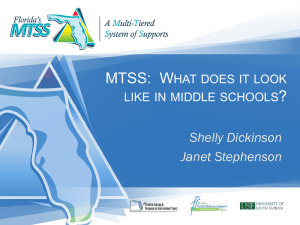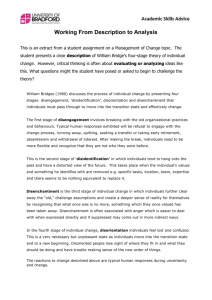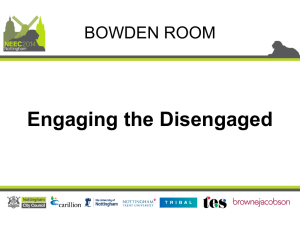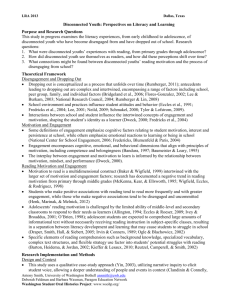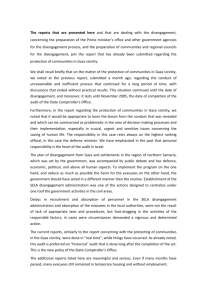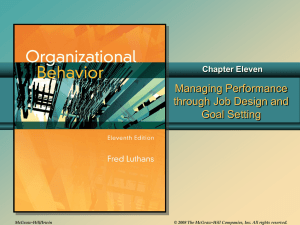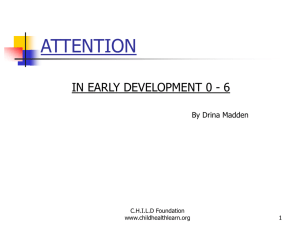Problem Memorandum
advertisement
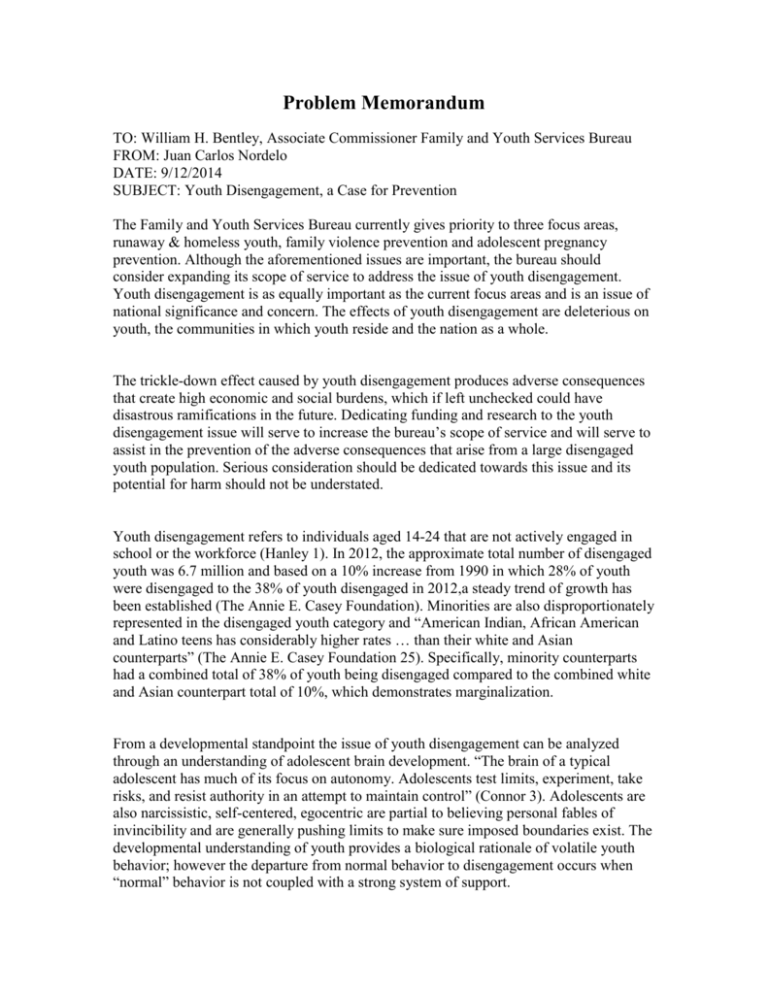
Problem Memorandum TO: William H. Bentley, Associate Commissioner Family and Youth Services Bureau FROM: Juan Carlos Nordelo DATE: 9/12/2014 SUBJECT: Youth Disengagement, a Case for Prevention The Family and Youth Services Bureau currently gives priority to three focus areas, runaway & homeless youth, family violence prevention and adolescent pregnancy prevention. Although the aforementioned issues are important, the bureau should consider expanding its scope of service to address the issue of youth disengagement. Youth disengagement is as equally important as the current focus areas and is an issue of national significance and concern. The effects of youth disengagement are deleterious on youth, the communities in which youth reside and the nation as a whole. The trickle-down effect caused by youth disengagement produces adverse consequences that create high economic and social burdens, which if left unchecked could have disastrous ramifications in the future. Dedicating funding and research to the youth disengagement issue will serve to increase the bureau’s scope of service and will serve to assist in the prevention of the adverse consequences that arise from a large disengaged youth population. Serious consideration should be dedicated towards this issue and its potential for harm should not be understated. Youth disengagement refers to individuals aged 14-24 that are not actively engaged in school or the workforce (Hanley 1). In 2012, the approximate total number of disengaged youth was 6.7 million and based on a 10% increase from 1990 in which 28% of youth were disengaged to the 38% of youth disengaged in 2012,a steady trend of growth has been established (The Annie E. Casey Foundation). Minorities are also disproportionately represented in the disengaged youth category and “American Indian, African American and Latino teens has considerably higher rates … than their white and Asian counterparts” (The Annie E. Casey Foundation 25). Specifically, minority counterparts had a combined total of 38% of youth being disengaged compared to the combined white and Asian counterpart total of 10%, which demonstrates marginalization. From a developmental standpoint the issue of youth disengagement can be analyzed through an understanding of adolescent brain development. “The brain of a typical adolescent has much of its focus on autonomy. Adolescents test limits, experiment, take risks, and resist authority in an attempt to maintain control” (Connor 3). Adolescents are also narcissistic, self-centered, egocentric are partial to believing personal fables of invincibility and are generally pushing limits to make sure imposed boundaries exist. The developmental understanding of youth provides a biological rationale of volatile youth behavior; however the departure from normal behavior to disengagement occurs when “normal” behavior is not coupled with a strong system of support. Disengaged youth are most commonly devoid of any source of stable social support and without the advantages provided by strong support systems, youth are unable engage in school and/or the workforce. Disengaged youth are “basically abandoned, with no supports, no money, no place to stay and no home to return to if things get rough. Let us face the fact that without the supports and advantages most of us are accustomed to, we are all just one step away from disconnection ourselves” (Connor 2-3). An utter lack of any informal or formal support system is the root cause of youth disengagement. Support can come from a variety of sources and as such disengagement factors can be further categorized based on the particular system of support. In school disengagement factors can be based on the individual, meaning that there is a disinterest in classes, consistent underperformance, truancy/absenteeism and a lack of discipline that can steer youth towards disengaging. (Hanley 2). School staff can also be blamed in some instances where teachers undervalue their students, indirectly prompting students to disengage. An article in the Washington Post focusing on the disengagement of Latino youth in Montgomery County states that “Latino students who experienced low expectations from high school teachers or counselors were more than 3.5 times as likely to report being drop outs as those who said they were met with high expectations.” (George 3). The personal/family support system can also cause youth disengagement because socioeconomic factors might prompt students to disengage from school in order to earn money to contribute to the family’s income. Other factors include a lack of emotional support from parents, parent stances on education and the family’s disengagement history. Additionally low income youth are less likely to remain engaged in school than their middle-income and high-income counterparts. Disengagement from school has a direct impact on disengagement from work because youth do not have the skill and knowledge base necessary to attain and keep a full-time or part-time position. Additionally, some youth are unsure about what career path they might want to pursue and avoid engaging in work out of confusion. (Hanley) In either case, disengagement from school remains to be the primary issue of concern because “earning a high school diploma or its equivalent is a necessary requirement for future credentials that will lead to family sustaining employment and productive adulthood” (Hanley 3). The individual impact of youth disengagement is severe and limits the amount of success and productivity that can be attained in adulthood. Disengaged youth face extremely scarce employment opportunities, which is compounded by an education deficit. The completion of high school in today’s job market is not sufficient enough to meet the minimum requirements of full-time employment and necessitates the completion of postsecondary schooling. Therefore youth that disengage from high school have no base on to which they can rely for family sustaining employment. “According to a Harvard Graduate School of Education study, in the ten year period from 2008 – 2018 the U.S. economy will create 47 million jobs. However, only 36 percent of these jobs will be available to individuals with a high school diploma or less.” (Hanley 2) Disengaged youth will not be able to participate in the workforce due to their lack of education and will ultimately place an estimated societal burden of $704,020 over their lifetime as they acquire public benefits, enter the prison system, are unhealthy, etc. (Hanley) Disengaged youth also negatively impact the communities where they reside, as they are more prone to engaging in criminal activities, disrupting community livability. Additionally lower individual earnings as a result of disengagement translate to fewer taxes paid “which translates to a loss of 11.3 billion dollars in taxes loss every year” (Hanley 5). The issue of youth disengagement is one that causes a significant burden on the individual, community and nation as a whole. Youth need to finish high school and engage in post secondary education in order to have a successful transition into a productive adulthood. The cause of youth disengagement is a lack of support from an early on-set which can be easily addressed through a combination of early intervention strategies in which youth receive the care and attention they deserve. This issue can be easily prevented through a nation-die campaign and through further research and dedication, effective policy measures can be enacted. These policy measures would prevent youth from becoming a burden/cost to society and would allow youth to give back by succeeding. If the Family and Youth Services Bureau, expands its focus area to include youth disengagement, momentous change can and will occur. I would like to thank you for your time, attention and consideration on this matter. It is my opinion that the Family and Youth Services Bureau have both the resources and knowledge to create a sustainable social impact for youth throughout the nation. I am happy to discuss this recommendation with you at your earliest convenience and will assist you in any decision that you make. Works Cited Connor, Jenn O'. Disconnected Youth: An Answer to Preventing Disengagement. Ed. Karen Schimke and Sara Harmon. Comp. Mark Savary and Carole Holden. Albany: Schuyler Center for Analysis and Advocacy, 2007. Print. George, Donna St. "Report shows school disengagement among Latino Youth." Washington Post 19 June 2014, Education: 1-6. Print. Hanley, Kate, et al. Youth Career Development. Boston: Root Cause Social Impact Research, 2012. Print. Education and Youth Development. The Annie E. Casey Foundation. The 2014 KIDS COUNT Data Book. Baltimore: The Annie E. Casey Foundation, 2014. Web. 11 Sept 2014.

